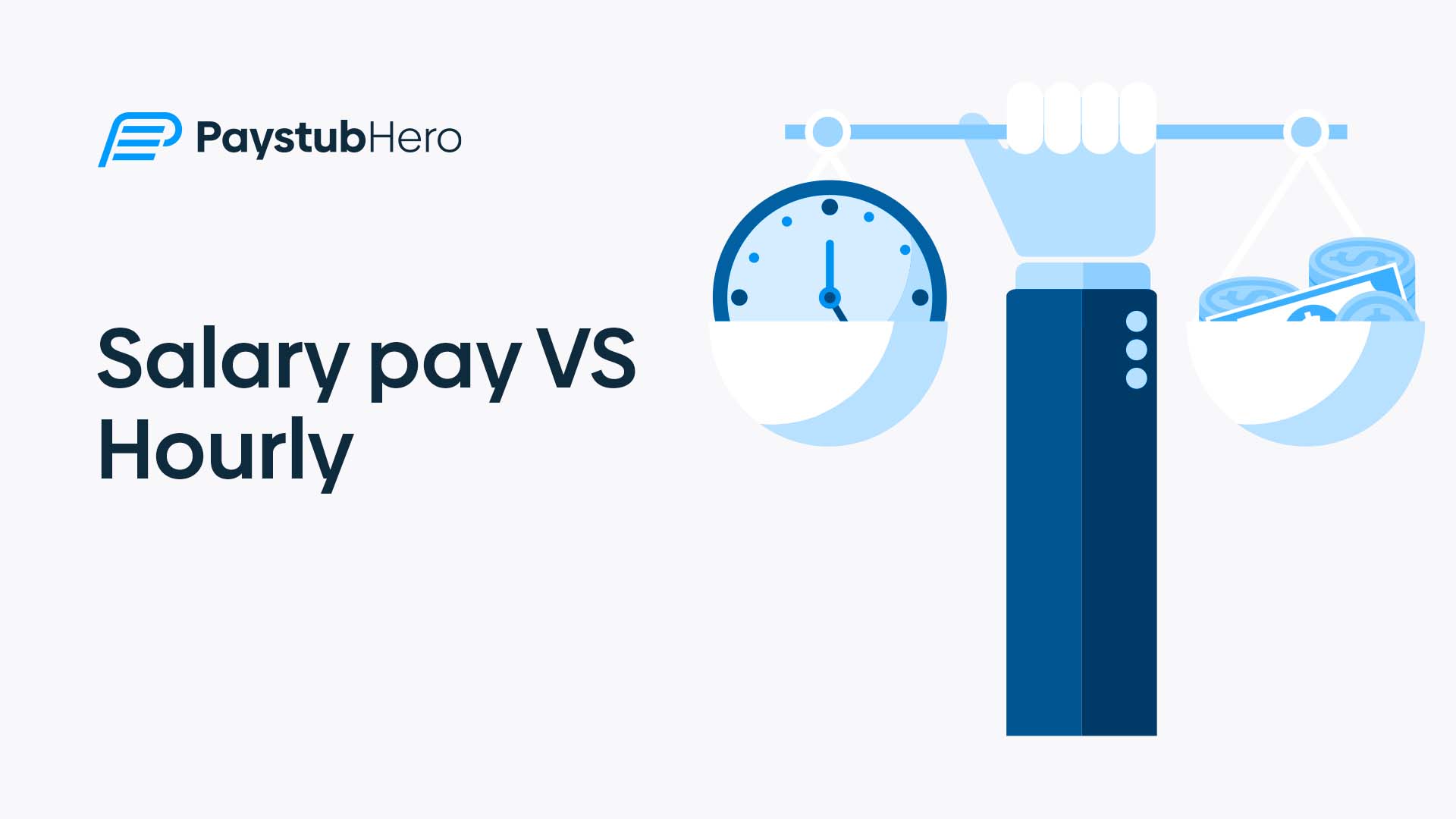Choosing between salary and hourly payment is a decision faced by millions of workers and employers around the globe. It’s not just about selecting an employment contract. It’s about understanding how the payment structure, whether it’s salary pay vs hourly pay, impacts your professional life and personal finances.
As an employee, this choice can influence your income stability, work-life balance, potential benefits, and even your career trajectory.
For employers, the decision shapes not only your payroll, but also impacts employee satisfaction, retention, and the overall operational cost. The question is, which one suits your needs the most – salary or hourly pay?
In the salary vs hourly debate, the focus isn’t just on the immediate dollar amount appearing on your paystub.
Instead, the question lies deeper, in factors such as the flexibility offered by hourly wages and the security provided by a salaried position. In essence, the decision weaves into the fabric of your job satisfaction and your overall quality of life.
In this comprehensive guide, we’ll delve into each payment structure’s characteristics, advantages, and the essential factors to consider when comparing the two.
With a clear understanding, you’ll be better equipped to make the decision that aligns best with your unique circumstances.
Table of Contents
- Introduction: Salary Pay vs Hourly: The Crucial Considerations
- Understanding the Basics: Salary Definition and Hourly Rates in a Nutshell
- Salary Pay vs Hourly Pay: A Comprehensive Comparison of the Advantages
- Navigating Pay Structures: Unraveling the Hourly to Salary Conversion
- What Does Salary Mean for Your Career Path? Decoding the Impact of Salaried Positions
- Decision Time: Salary Pay vs Hourly – Selecting the Best Fit for Your Needs
- Making Payroll Simpler with Paystubhero: Your Ally in Streamlined Compensation Management
Understanding the Basics: Salary Definition and Hourly Rates in a Nutshell
Before diving into the specifics of the salary vs hourly pay debate, it’s crucial to establish a fundamental understanding of what each payment method entails. Misconceptions or misunderstandings about these payment structures can make the choice between salary and hourly seem more complex than it needs to be.
By clearly defining these terms, we can lay a strong foundation for our exploration of this topic.
A salary, by definition, is a fixed regular payment agreed upon by an employer and an employee. Typically, this payment is made on a monthly or biweekly basis. Salaried employees earn a predetermined annual amount that is divided evenly across the year’s pay periods.
Regardless of the number of hours they’ve worked during a pay period, they receive the same amount of money. This consistency is one of the main attractions of a salaried position, providing a predictable income that facilitates financial planning.
On the flip side of the coin, we have hourly payment. Unlike their salaried counterparts, hourly workers are paid based on the actual hours they’ve worked during a given pay period.
If an hourly employee works more or fewer hours in a particular week, their earnings will reflect this change. This structure provides flexibility and direct control over income based on hours worked.
Grasping these fundamental definitions and differences is the first step in evaluating which pay structure – salary or hourly – aligns best with your work expectations and financial needs.
With this understanding, we can now delve deeper into the pros and cons of salary pay vs hourly pay.
Salary Pay vs Hourly Pay: A Comprehensive Comparison of the Advantages
When weighing the choice between salary pay vs hourly pay, it’s essential to consider the unique advantages that each compensation structure brings to the table. This comparison is about more than just the numbers on your paystub.
It includes how each pay type may impact various aspects of your work life, from your professional growth and job stability to your personal lifestyle and financial planning.
One of the most significant benefits of salaried positions lies in their stability and predictability.
As a salaried employee, you know exactly how much you’re going to make each month, making it easier for budgeting and long-term financial planning. This stability often extends to job security, as salaried roles are typically less vulnerable to fluctuations in the economy or business.
Beyond the financial stability, salaried roles often come with other advantages such as health benefits, retirement contributions, and opportunities for career progression. Such benefits can significantly contribute to your overall job satisfaction and long-term financial wellbeing.
On the other hand, hourly roles also carry distinct benefits, especially in terms of flexibility. With an hourly job, you have the ability to control the amount you earn by adjusting the number of hours you work. If you’re willing and able to work more, you can increase your earnings.
Likewise, if you need to cut back on hours due to personal circumstances, you have that flexibility.
Moreover, hourly roles can be an ideal choice for those seeking to balance work with other life commitments, such as family, education, or even a side hustle. The ability to choose your hours and the direct correlation between time worked and pay received can offer a sense of control and adaptability that is highly valued by many employees.
As we examine these advantages, it becomes clear that the decision between salary pay vs hourly pay isn’t a one-size-fits-all situation. The right choice will depend on your unique circumstances, values, and career goals. With these insights in mind, let’s explore the practical considerations of navigating between these two pay structures.
Navigating Pay Structures: Unraveling the Hourly to Salary Conversion
As we further unpack the complexities of salary pay vs hourly pay, it’s imperative to address a practical aspect that both employees and employers might encounter – the conversion from hourly to salary pay.
Understanding this conversion isn’t just a mathematical exercise, but a crucial step in accurately assessing job offers or potential changes to your employment structure.
Whether you’re an hourly employee contemplating a transition to a salaried position, or an employer looking to redefine your pay structure, it’s essential to understand how your annual income or wage costs might change.
This understanding allows you to make informed decisions, ensuring your choices are financially sound and fit your goals and needs.
For example, let’s say you’re currently an hourly worker making $20 per hour. To grasp what this would look like as a salary, you need to consider the typical number of work hours in a year.
Assuming a standard 40-hour workweek and 52 weeks per year (given that you work every week of the year without time off), this translates to an annual income of $41,600 before taxes and deductions.
On the other hand, if you’re considering a salaried position offering $45,000 per year, it can be helpful to know what that equates to on an hourly basis. Given the same number of working hours, you’d be earning roughly $21.63 per hour.
Knowing this can provide a clearer comparison between your current hourly rate and potential salary.
However, it’s also essential to remember that the transition between hourly and salary isn’t just about the numbers. Consideration must be given to other factors such as workload, job responsibilities, flexibility, benefits, and potential overtime pay, all of which can influence the perceived value and suitability of a particular pay structure.
In the next section, let’s delve into what choosing a salaried position can mean for your broader career path and job responsibilities.
What Does Salary Mean for Your Career Path? Decoding the Impact of Salaried Positions
When asking, “what does salary mean for your career path?” we are investigating the broader implications that choosing a salaried position can have on your professional journey. The compensation structure you opt for can significantly influence your work dynamics, responsibilities, and progression opportunities.
Therefore, understanding these nuances is essential when making an informed decision between salary pay vs hourly pay.
Choosing a salaried position often comes with increased responsibilities and heightened expectations. In many instances, salaried roles are associated with managerial or supervisory duties, strategic planning, or specialized tasks that require specific skills or qualifications.
While this could potentially mean working beyond standard hours, it also provides an opportunity to gain valuable experience and prove your capabilities, which can be pivotal for career advancement.
On the other hand, taking on a salaried position could also affect your work-life balance, as you might be expected to work overtime without additional compensation. This expectation may be acceptable for some, particularly if the role offers a competitive salary, significant career progression opportunities, or exceptional non-monetary benefits.
However, for others, the potential impact on personal time or family commitments may be a drawback.
The implications of a salaried position also extend to your financial future. With more predictable earnings, financial planning becomes easier. You may find it simpler to plan for major life milestones, such as buying a home, investing, or planning for retirement.
In the end, a salaried role can mean different things depending on your career aspirations, personal goals, and the specific job circumstances. Therefore, it’s essential to consider all these aspects and how they align with your current lifestyle and future plans before making a decision.
As we wrap up our comprehensive exploration of salary pay vs hourly pay, let’s revisit the crucial factors that can guide your choice.
Decision Time: Salary Pay vs Hourly – Selecting the Best Fit for Your Needs
As we reach the culmination of our discussion on salary pay vs hourly pay, it’s decision time. But, how do you choose the compensation structure that best aligns with your needs and goals?
The choice isn’t always black and white, and it’s essential to consider all the information we’ve discussed, looking beyond just the immediate financial considerations.
When deciding between a salaried position and an hourly role, one must consider their personal circumstances, career aspirations, and lifestyle preferences. A salaried position may be more attractive if you value stability and predictability in your income, desire more comprehensive benefits, or seek opportunities for career growth.
On the other hand, an hourly role could be more suitable if you value flexibility in your schedule and want to have direct control over the correlation between the hours you work and your pay.
Hourly work might also be more appealing if you’re balancing other commitments such as school, family responsibilities, or a second job.
Regardlessof which option you lean toward, it’s crucial to remember that no choice is set in stone. Your needs and circumstances may change over time, and it’s perfectly normal to switch between salary and hourly pay as your career progresses.
Finally, it’s essential to note that whether you’re paid hourly or on a salary basis, your value as an employee isn’t defined solely by your compensation structure. Your worth is also determined by your skills, experiences, work ethic, and the unique contributions you make to your workplace.
As we conclude our exploration of salary pay vs hourly pay, remember that understanding your compensation is an important aspect of work life. With this knowledge in hand, you can make informed decisions that align with your personal and professional goals.
Making Payroll Simpler with Paystubhero: Your Ally in Streamlined Compensation Management
After delving into the intricacies of salary pay vs hourly pay, it’s clear that understanding and managing payroll can be a complex task, especially for entrepreneurs, freelancers, small businesses, and independent contractors.
Traditional payroll software can be costly and may not cater to the unique needs of these individuals and smaller entities. That’s where Paystubhero enters the scene, bringing simplicity, efficiency, and affordability to payroll management.
Paystubhero is an online payroll software designed specifically to meet the needs of entrepreneurs, freelancers, and small businesses.
Recognizing that traditional payroll systems like ADP or Gusto often cater to larger businesses, leaving smaller entities underserved, Paystubhero provides a robust yet simplified solution.
With Paystubhero, users simply enter their company or employee information, and the software takes care of the rest, effortlessly handling calculations to ensure accurate paystubs.
The process is as easy as 1-2-3, making payroll management a breeze, even for those with minimal financial expertise.
Beyond ease of use, Paystubhero enables users to generate their documents quickly and efficiently. This speed and efficiency can be a game-changer for small business owners and freelancers, helping them save time and focus on what they do best – growing their business and serving their clients.
As we conclude our discussion on salary pay vs hourly pay, it’s clear that no matter which pay structure you opt for, managing payroll doesn’t have to be a daunting task.
CWith solutions like Paystubhero, you can streamline your payroll process and focus more on your core business operations and professional development.
Experience the simplicity and convenience of Paystubhero today and see how it transforms your payroll management. Sign up now and let Paystubhero take care of your payroll, so you can take care of business.
Frequent Asked Questions
Is it better to get salary or hourly?
It depends on your personal needs and professional goals. Salary can provide stable income and may come with additional benefits, while hourly pay offers more flexibility and can lead to higher pay with overtime work.
What are the pros and cons of being on salary?
- Pros: Steady income, potential benefits, and opportunities for career advancement.
- Cons: May require working extra hours without additional pay, and can have less flexibility in work schedule compared to hourly roles.
Should I take a salary position?
It depends on your career goals, work-life balance needs, and the specific job offer. Consider the salary amount, job responsibilities, potential for advancement, and the benefits package when making this decision.
What is an example of a salary?
An example of a salary would be an annual income of $50,000 for a full-time job, regardless of the exact number of hours worked each week. This amount is typically divided into equal payments distributed over the course of the year.





